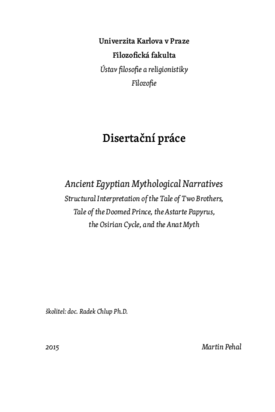Ancient Egyptian Mythological Narratives. Structural Interpretation of the Tale of Two Brothers, Tale of the Doomed Prince, the Astarte Papyrus, the Osirian Cycle and the Anat Myth
Staroegyptské mytologické narativy. Strukturalistické interpretace Příběhu o dvou bratrech, Příběhu o princi, kterému byl předurčen osud, Astartina papyru, Usirovského cyklu a Anatina mýtu
dizertační práce (OBHÁJENO)

Zobrazit/
Trvalý odkaz
http://hdl.handle.net/20.500.11956/77928Identifikátory
SIS: 105302
Katalog UK: 990020492260106986
Kolekce
- Kvalifikační práce [24672]
Autor
Vedoucí práce
Oponent práce
Spalinger, Anthony John
Stauder, Andreas
Fakulta / součást
Filozofická fakulta
Obor
Religionistika
Katedra / ústav / klinika
Ústav filosofie a religionistiky
Datum obhajoby
27. 11. 2015
Nakladatel
Univerzita Karlova, Filozofická fakultaJazyk
Angličtina
Známka
Prospěl/a
Klíčová slova (česky)
literatura, egyptská Nová říše, text, struktura, Příběh dvou bratrů, Papyrus Astarte, Příběh o princi, kterému byl předurčen osud, Usirův mýtus, mýtus, mytologie, kulturní vliv, cizí na Egypt, Anat, bůh, cizí v Egyptě, blízkovýchodní náboženství, Blízký východ, Sýrie-Palestina, narativ, mýtus o Anatě, gender, král, poziční nástupnictví, strukturalizmusKlíčová slova (anglicky)
literature NK, text, structure of, Tale of two Brothers, Astarte-Papyrus, Osiris myth, Tale of the Doomed Prince, myth, mythology, cultural influence, foreign on Egypt, Anat, god, foreign in Egypt, Near Eastern religion, Near East, Syria-Palestine, narratives, Anat Myth, gender, king, positional kingship, structuralismis study is composed of two units: manuscript of the author's publication Interpreting Ancient Egyptian Narratives: A Structural Analysis of the Tale of Two Brothers, the Anat Myth, the Osirian Cycle, and the Astarte Papyrus (Nouvelles études orientales, Bruxelles-Fernelmont: EME, 2014) and an additonal chapter entitled Accommodating Ambivalence: Case of the Doomed Prince and His Dog, which follows directly a er the Index of the first unit and which extends the applied methodology to yet another New Kingdom mythological narrative, the so-called Tale of the Doomed Prince. Methodologically, the author follows the neo-structuralist approach. Both studies explain the strong configurational character of ancient Egyptian (mythological) thought which has the ability to connect various ontological levels of human experience with the surrounding world into complex synchronic structures. ese symbolical systems are shown to be mediating between the various cultural paradoxes which were inherent to ancient Egyptian society. Axial role in this process is a ributed to the institution of positional kingship represented by the Pharaoh. Its transformative function is also put into relation to the special status of female characters who are shown to play the part of the "powerful powerless ones" further personifying...
is study is composed of two units: manuscript of the author's publication Interpreting Ancient Egyptian Narratives: A Structural Analysis of the Tale of Two Brothers, the Anat Myth, the Osirian Cycle, and the Astarte Papyrus (Nouvelles études orientales, Bruxelles-Fernelmont: EME, 2014) and an additonal chapter entitled Accommodating Ambivalence: Case of the Doomed Prince and His Dog, which follows directly a er the Index of the first unit and which extends the applied methodology to yet another New Kingdom mythological narrative, the so-called Tale of the Doomed Prince. Methodologically, the author follows the neo-structuralist approach. Both studies explain the strong configurational character of ancient Egyptian (mythological) thought which has the ability to connect various ontological levels of human experience with the surrounding world into complex synchronic structures. ese symbolical systems are shown to be mediating between the various cultural paradoxes which were inherent to ancient Egyptian society. Axial role in this process is a ributed to the institution of positional kingship represented by the Pharaoh. Its transformative function is also put into relation to the special status of female characters who are shown to play the part of the "powerful powerless ones" further personifying...
